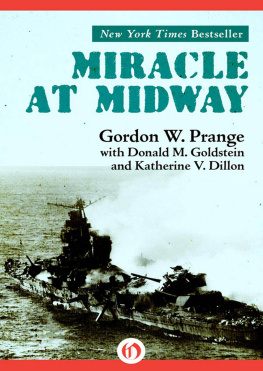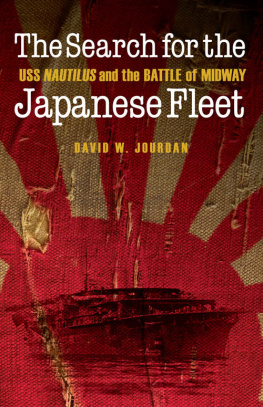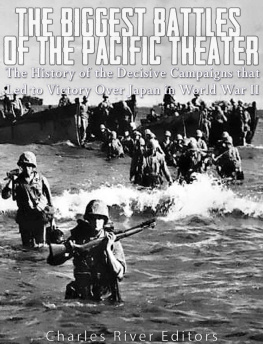
In Memory of Lt Charles Rollins Ware, USN
Dive-bomber pilot (VS-6)
Killed in action at Midway

Contents
First of foremost, I would like to thank Phil McClusky, without whose assistance this book could not have been written. Phil shared all of his fathers papers and pilot logbooks with me, as well as several photographs. He even let me take over his dining room table to go through the material. Phils enthusiasm about having his fathers story told has been of enormous assistance to me and his large collection of his fathers papers was an indispensable resource. Carole McClusky-Pewthers was kind enough to share her memories of her late husband, Wade Sanford McClusky, with me. I am indebted to Betty Beason and Anne Hopkins for allowing me to use the Midway diagram as modified by their father, Lewis Hopkins. Similarly, I am indebted to Wayne Goldsmith for allowing me to use the same diagram as modified by his father, George H. Goldsmith.
I exchanged emails with several Midway scholars, whose insights have been most helpful. In this regard, I would like to thank Barrett Tillman, Mark Horan, Thom Walla, Timothy and Laura Orr, and George Walsh. Matt Parsons was kind enough to scan and send me some photographs.
I would like to thank Lisa Thomas at Bloomsbury UK for believing in this project and for being a pleasure to work with.
I would like to thank the staff of the National Archives at College Park, Maryland as well Adam Minakowski, Reference & Special Collections Librarian at the Nimitz Library at the United States Naval Academy. The Staff of the Naval History and Heritage Command kindly allowed me to review the Walter Lord collection of papers at the Washington Navy Yard. The staff of the National Naval Aviation Museum sent me McCluskys Midway after action report, a short Navy Department biographical sketch of Wade McClusky, and a photograph. Eleanor Uhlinger, the University Librarian at the Dudley Knox Library at the Naval Postgraduate School in Monterey sent me some excellent background material dealing with Wade McCluskys time at Monterey. Monica Holland and Rachelle Rennagel provided me with excellent legal advice. Christophe Marchal provided an excellent preliminary cover design.
Any errors or omissions remain my responsibility alone.
During the Battle of Midway in June 1942, US Navy pilot Wade McClusky proved himself to be one of the greatest pilots and combat leaders in American history, but his story has never been told until now.
The grand strategy involved in the Battle of Midway is well known and does not need retelling. What is needed in the literature on the Battle of Midway is a book chronicling the contributions to American victory made by then Lt Cdr C. Wade McClusky, Jr, air group commander of the USS Enterprise (CV-6). It was Wade McClusky who remained calm when the Japanese fleet was not where he expected it to be. It was McClusky who made the counterintuitive choice to then search to the north instead of to the south. It was also McClusky who took the calculated risk of continuing to search even though he knew that the 32 pilots in his two squadrons of dive-bombers were all running dangerously low on fuel and that even if they found the enemy, his boys would barely have enough fuel left to make it back to the Enterprise . McCluskys ability to remain calm under enormous pressure enabled him to find the Japanese fleet, which in turn enabled the pilots under his direct command to deliver the attacks that destroyed two of the four Japanese aircraft carriers sunk at Midway.
Every book about the Battle of Midway mentions Wade McClusky, but usually only in passing, as if his actions on June 4, 1942 were somehow ordinary. McCluskys immediate superiors, by contrast, knew differently. Just after the Battle of Midway, USS Enterprise captain George D. Murray, Task Force 16 commander R Adm Raymond Spruance, and Commander-in-Chief of the US Pacific Fleet Adm Chester W. Nimitz all stated that Wade McClusky had made the single most important contribution to American victory in one of the most utterly decisive naval battles in all of history. Somehow over time, however, these early accolades became forgotten so that by the time of his death in 1976, Wade McClusky had faded into obscurity.
It is my sincere hope that this book will change all that by breathing life into a man who is treated in other accounts of the Battle of Midway as a shadowy background figure. Being one of the oldest pilots in the Navy in 1942 gave McClusky the gravitas to handle unexpected situations. It also made him one of the most experienced pilots in the US Navy in terms of the hours of hands-on flying time he had logged. Having completed his flight training more than a decade prior to Pearl Harbor meant that McClusky was experienced in, and familiar with the characteristics of, every type of aircraft in the naval inventory of the time dive-bombers, fighter planes, and torpedo planes.
There was something serendipitous about the timing of Wade McCluskys entry into naval service. Graduating from the US Naval Academy in 1926, he went on active duty just one year before the US Navy received its first two true aircraft carriers, USS Lexington (CV-2) and USS Saratoga (CV-3). Thus, when he underwent flight training in late 1928 and early 1929, McClusky was getting in on the ground floor of naval aviation, which, as history has shown, was where the Navys future lay.
There have been accusations made in recent literature on the Battle of Midway to the effect that Wade McClusky was supposedly unfamiliar with dive-bombing doctrine and that he therefore supposedly bungled the dive-bombing attacks made against the Imperial Japanese Navy (IJN) aircraft carriers Akagi and Kaga . I intend to disprove these fallacies. There is a wealth of information available to refute these inaccurate accusations, beginning with the fact that both of the targets Wade McClusky selected for his group of pilots to attack were in fact destroyed in the attack McClusky led. How can he then have bungled? It is hard to argue with success.
Most of all, this is a story about destiny; about how, as stated by historian George J. Walsh, Wade McCluskys story is the story of the right man in the right place at the right time This book is his story.
Notes
.
Ibid.
Right now Wade McClusky had a problem. In fact, he had several problems. It was 9.30am on the morning of June 4, 1942. McClusky was flying at 19,000ft in a Douglas SBD-3 Dauntless dive-bomber at the head of two squadrons of USS Enterprise dive-bombers, Scouting Six (VS-6) and Bombing Six (VB-6); 33 aircraft in all, including the one he and his rear seat gunner/radio operator Walter G. Chocalousek were riding in. McCluskys group had been in the air for two-and-a-half hours. The fuel situation was becoming critical for everyone. McClusky and his two wingmen, Ensigns Bill Pittman and Dick Jaccard, had attached themselves to Scouting Six for the days mission. Every aircraft in VS-6, including those of McClusky, Pittman, and Jaccard, was carrying a 500lb bomb affixed to the belly of the airplane. In addition to the 500lb bomb, nine of the 15 aircraft in VS-6 were also each carrying two 100lb bombs; one under each wing. McClusky and his wingmen each carried just one 500lb bomb each. All of the 15 pilots of Bombing Six carried one 1,000lb bomb each. All of this ordnance would be useless, however, unless Wade McClusky could solve his biggest problem figuring out where the enemy was.











